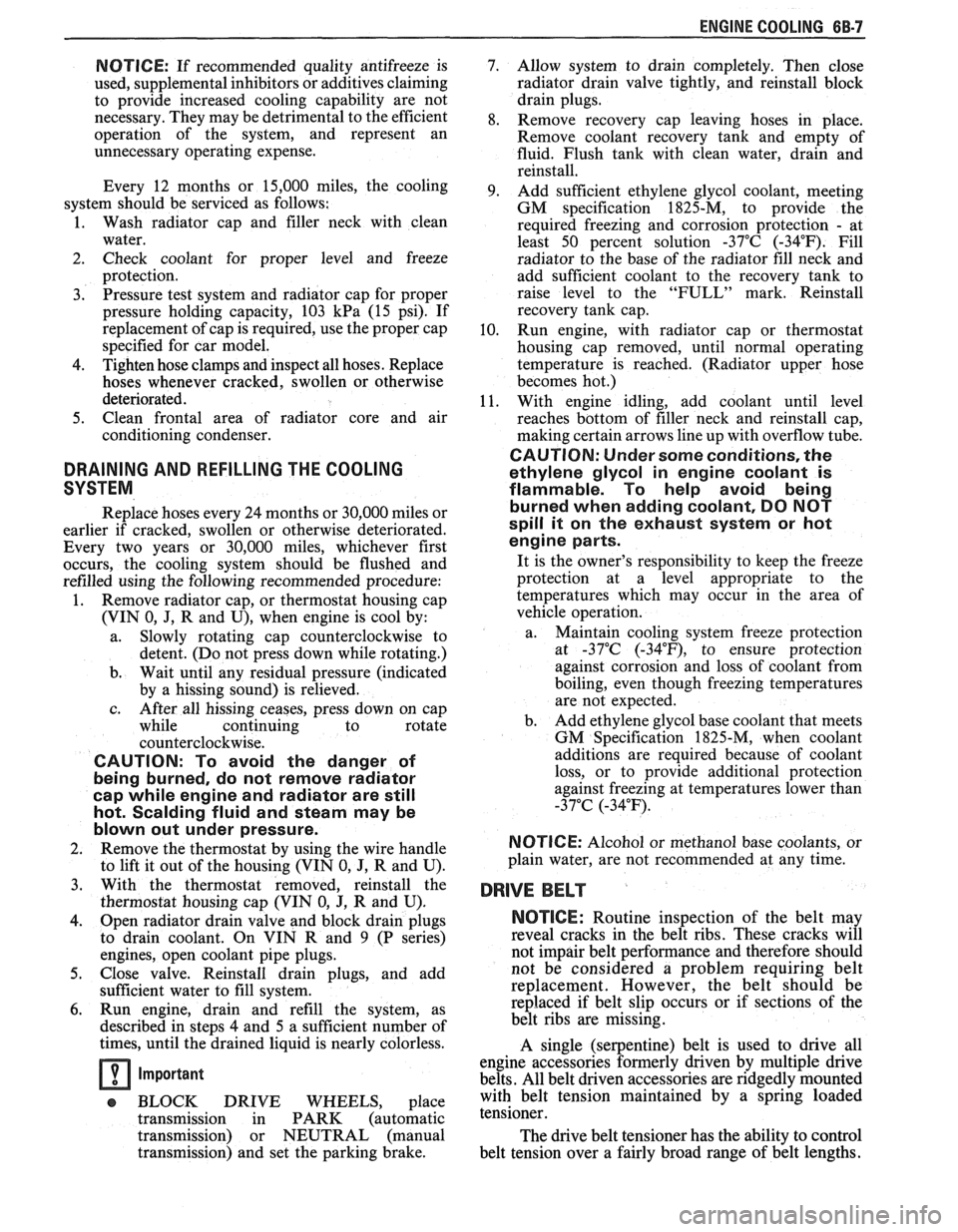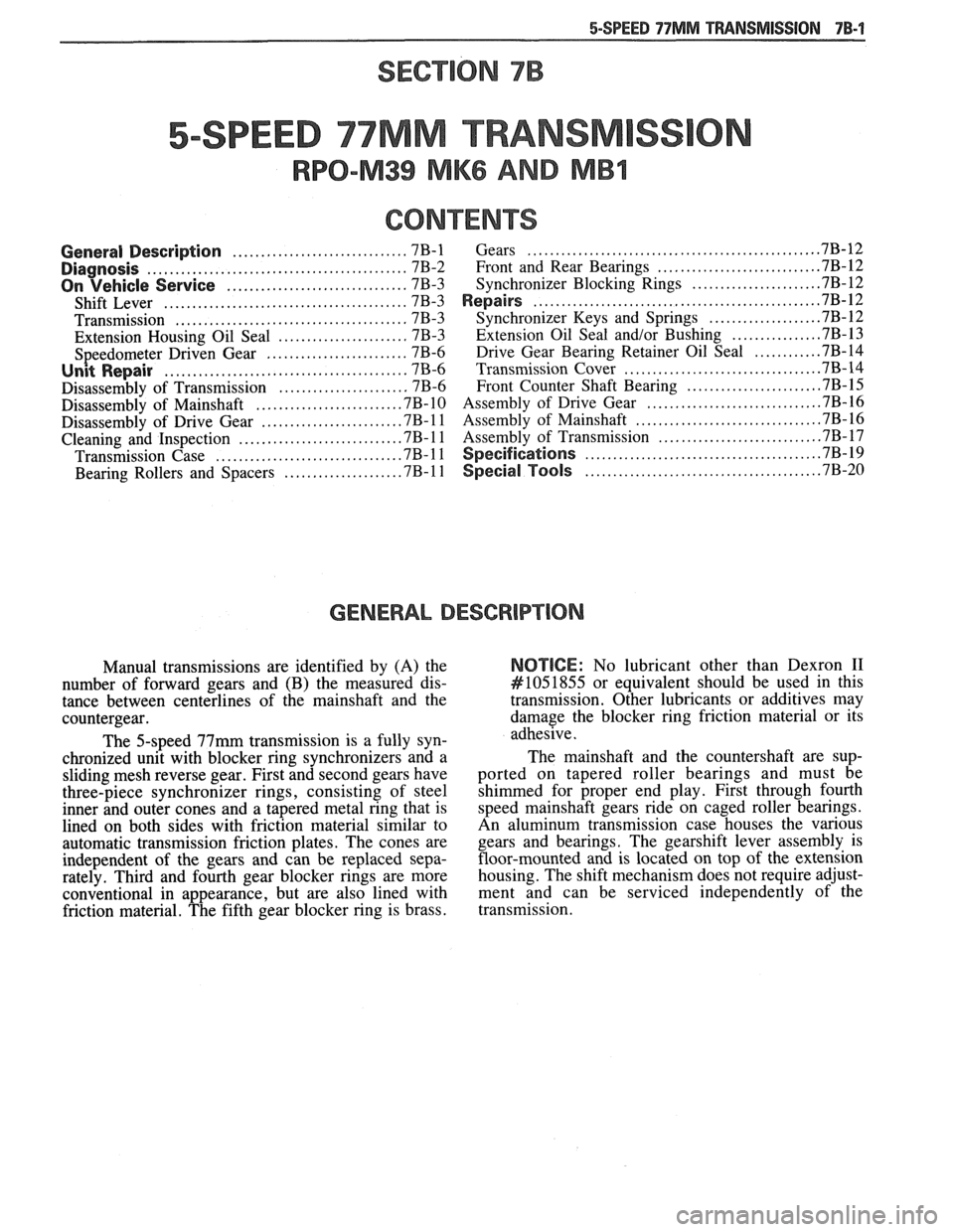oil additives PONTIAC FIERO 1988 Service Repair Manual
[x] Cancel search | Manufacturer: PONTIAC, Model Year: 1988, Model line: FIERO, Model: PONTIAC FIERO 1988Pages: 1825, PDF Size: 99.44 MB
Page 418 of 1825

ENGINE COOLING BB-7
NOTICE: If recommended quality antifreeze is
used, supplemental inhibitors or additives claiming
to provide increased cooling capability are not
necessary. They may be detrimental to the efficient
operation of the system, and represent an
unnecessary operating expense.
Every 12 months or 15,000 miles, the cooling
system should be serviced as follows;
1. Wash radiator cap and filler neck with clean
water.
2. Check coolant for proper level and freeze
protection.
3. Pressure test system and radiator cap for proper
pressure holding capacity, 103
kPa (15 psi). If
replacement of cap is required, use the proper cap
specified for car model.
4. Tighten hose clamps and inspect all hoses. Replace
hoses whenever cracked, swollen or otherwise
deteriorated.
5. Clean frontal area of radiator core and air
conditioning condenser.
DRAINING AND REFILLING THE COOLING
SYSTEM
Replace hoses every 24 months or 30,000 miles or
earlier if cracked, swollen or otherwise deteriorated.
Every two years or 30,000 miles, whichever first
occurs, the cooling system should be flushed and
refilled using the following recommended procedure:
1. Remove radiator cap, or thermostat housing cap
(VIN
0, J, R and U), when engine is cool by:
a. Slowly
rotating cap counterclockwise to
detent. (Do not press down while rotating.)
b. Wait until any
residual pressure (indicated
by a hissing sound) is relieved.
c. After all hissing ceases, press down on cap
while continuing to rotate
counterclockwise.
CAUTION: To avoid the danger of
being burned, do not remove radiator
cap while engine and radiator are still
hot. Scalding fluid and steam may be
blown out under pressure.
2. Remove the thermostat by using the wire handle
to lift it out of the housing (VIN
0, J, R and U).
3. With the thermostat removed, reinstall the
thermostat housing cap (VIN
0, J, R and U).
4. Open radiator drain valve and block drain plugs
to drain coolant. On VIN R and
9 (P series)
engines, open coolant pipe plugs.
5. Close valve. Reinstall drain plugs, and add
sufficient water to fill system.
6. Run engine, drain and refill the system, as
described in steps
4 and 5 a sufficient number of
times, until the drained liquid is nearly colorless.
Important
BLOCK DRIVE WHEELS, place
transmission in PARK (automatic
transmission) or NEUTRAL (manual
transmission) and set the parking brake. 7.
Allow system to drain completely. Then close
radiator drain valve tightly, and reinstall block
drain plugs.
8. Remove recovery cap leaving hoses in place.
Remove coolant recovery tank and empty of
fluid. Flush tank with clean water, drain and
reinstall.
9. Add sufficient ethylene glycol coolant, meeting
GM specification 1825-M, to provide the
required freezing and corrosion protection
- at
least 50 percent solution -37°C (-34°F). Fill
radiator to the base of the radiator fill neck and
add sufficient coolant to the recovery tank to
raise level to the "FULL" mark. Reinstall
recovery tank cap.
10. Run engine, with radiator cap or thermostat
housing cap removed, until normal operating
temperature is reached. (Radiator upper hose
becomes hot.)
11. With engine idling, add coolant until level
reaches bottom of filler neck and reinstall cap,
making certain arrows line up with overflow tube.
CAUTION: Under some conditions, the
ethylene glycol in engine coolant is
flammable. To help avoid being
burned when adding coolant, DO NOT
spill
it on the exhaust system or hat
engine parts.
It is the owner's responsibility to keep the freeze
protection at a level appropriate to the
temperatures which may occur in the area of
vehicle operation.
a. Maintain
cooling system freeze protection
at
-37°C (-34"F), to ensure protection
against corrosion and loss of coolant from
boiling, even though freezing temperatures
are not expected.
b. Add ethylene glycol base coolant that meets
GM Specification 1825-M, when coolant
additions are required because of coolant
loss, or to provide additional protection
against
freezing at temperatures lower than
-37°C (-34°F).
NOTICE: Alcohol or methanol base coolants, or
plain water, are not recommended at any time.
DRlVE BELT
NOTICE: Routine inspection of the belt may
reveal cracks in the belt ribs. These cracks will
not impair belt performance and therefore should
not be considered a problem requiring belt
replacement. However, the belt should be
replaced if belt slip occurs or if sections of the
belt ribs are missing.
A single (serpentine) belt is used to drive all
engine accessories formerly driven by multiple drive
belts. All belt driven accessories are ridgedly mounted
with belt tension maintained by a spring loaded
tensioner.
The drive belt tensioner has the ability to control
belt tension over a fairly broad range of belt lengths.
Page 1138 of 1825

SECTION 7B
5-SPEED 77MM TRANSM
RPO-M39 MK6 AND MBI
CONTENTS
........................... ................... ............................... General Description 7B-1 Gears ... 7B-12 .......................... .............................................. Diagnosis 7B-2 Front and Rear Bearings ..7B-12 ...................... ................................ On Vehicle Service 7B-3 Synchronizer Blocking Rings .7B-12 .................................................. ........................................... Shift Lever 7B-3 Repairs ,7B-12
......................................... ................... Transmission 7B-3 Synchronizer Keys and Springs .7B- 12
....................... ............... Extension Housing Oil Seal 7B-3 Extension
Oil Seal and/or Bushing .7B-13
Speedometer Driven Gear ......................... 7B-6
Drive Gear Bearing Retainer Oil Seal ............ 7B-14
........................................... .................................. Unit Repair 7B-6 Transmission Cover .7B-14
....................... ....................... Disassembly of Transmission 7B-6 Front Counter Shaft Bearing .7B-15 .............................. ......................... Disassembly of Mainshaft .7B- 10 Assembly of Drive Gear .7B- 16 ............................... ........................ Disassembly of Drive Gear ,7B- 1 1 Assembly of Mainshaft 7B- 16 ............................. ............................ Cleaning and Inspection ,7B-11 Assembly of Transmission 7B-17 ........................................ ............................... Transmission Case .7B-11 Specifications .7B-19
....................... .......... .................... Bearing Rollers and Spacers .7B-11 Special Tools ... .7B-20
GENERAL DESCRIPTION
Manual transmissions are identified by (A) the
number of forward gears and
(B) the measured dis-
tance between centerlines of the mainshaft and the
countergear.
The 5-speed 77mm transmission is a fully syn-
chronized unit with blocker ring synchronizers and a
sliding mesh reverse gear. First and second gears have
three-piece synchronizer rings, consisting of steel
inner and outer cones and
a tapered metal ring that is
lined on both sides with friction material similar to
automatic transmission friction plates. The cones are
independent of the gears and can be replaced sepa-
rately. Third and fourth gear blocker rings are more
conventional in appearance, but are also lined with
friction material. The fifth gear blocker ring is brass.
NOTICE: No lubricant other than Dexron I1
#I051855 or equivalent should be used in this
transmission. Other lubricants or additives may
damage the blocker ring friction material or its
adhesive.
The mainshaft and the countershaft are sup-
ported on tapered roller bearings and must be
shimmed for proper end play. First through fourth
speed mainshaft gears ride on caged roller bearings.
An aluminum transmission case houses the various gears and bearings. The gearshift lever assembly is
floor-mounted and is located on top of the extension
housing. The shift mechanism does not require adjust-
ment and can be serviced independently of the
transmission.